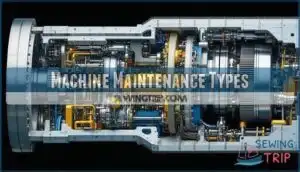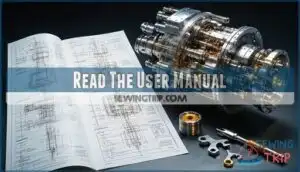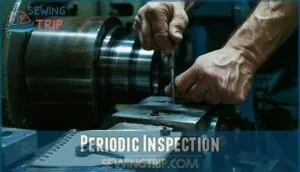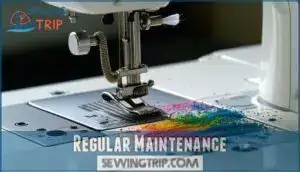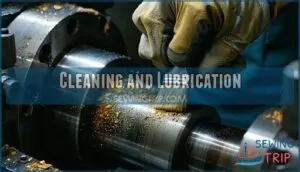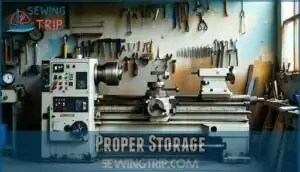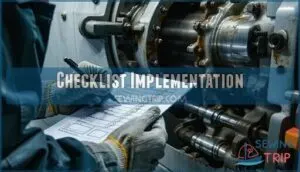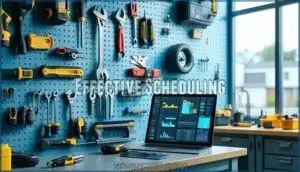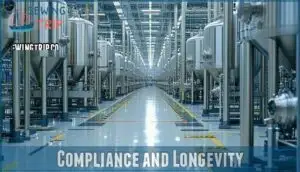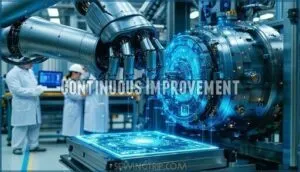This site is supported by our readers. We may earn a commission, at no cost to you, if you purchase through links.
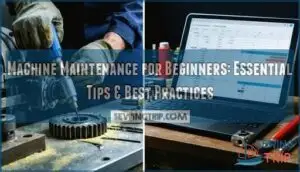
You’ll want to focus on three core areas: regular inspection, proper lubrication, and systematic cleaning. Check your equipment weekly for unusual sounds, vibrations, or wear patterns—these are early warning signs that something’s amiss.
Keep moving parts properly lubricated according to manufacturer specifications, and maintain clean work environments to prevent debris from damaging sensitive components.
Document everything you do; this creates a maintenance history that reveals patterns and helps predict future needs.
Think of it like caring for a car—regular oil changes and tune-ups cost far less than engine replacements. Master these fundamentals, and you’ll discover maintenance secrets that transform even the most intimidating industrial equipment into manageable, predictable systems.
Table Of Contents
Key Takeaways
- Focus on three core maintenance areas: You’ll prevent major equipment failures by conducting regular inspections for unusual sounds and wear patterns, maintaining proper lubrication according to manufacturer specs, and keeping work environments clean to protect sensitive components.
- Document everything you do: You’ll create a valuable maintenance history that reveals patterns and helps predict future equipment needs, transforming maintenance from guesswork into data-driven decisions that save money and prevent breakdowns.
- Implement preventive maintenance over reactive approaches: You’ll reduce repair costs by 30-60% and extend equipment life by 20-40% when you schedule routine maintenance before problems occur rather than waiting for equipment to fail completely.
- Start with manufacturer guidelines and build systematic habits: You’ll master machine maintenance by reading user manuals, following recommended schedules, and developing consistent daily routines for cleaning, lubrication, and inspection that keep equipment running smoothly.
Importance of Maintenance
When you skip machine maintenance, you’re basically gambling with expensive equipment that keeps your operations running.
Skip maintenance today, pay the price tomorrow with catastrophic equipment failure.
Regular maintenance isn’t just a good practice—it’s the difference between smooth production and costly emergency repairs that can shut down your entire workflow, which is a critical aspect of smooth production.
Prolongs Equipment Lifespan
Through proper machine maintenance basics, you’re basically giving your equipment a longer, healthier life.
Think of it like regular exercise for your machines – consistent care prevents premature wear and keeps components running smoothly for years beyond their expected lifespan.
- Preventive maintenance schedule keeps critical parts from failing unexpectedly
- Machinery inspection checklist catches small issues before they become major problems
- Part replacement at recommended intervals prevents cascading damage
- Asset optimization through maintenance scheduling maximizes your equipment’s working years
Regular maintenance is vital for preventing machine oil issues that can lead to equipment failure.
Increases Efficiency
Well-maintained machines don’t just last longer—they work smarter.
Regular maintenance scheduling software helps you track performance metrics and spot efficiency drops before they hurt your bottom line. Clean, lubricated equipment runs smoother, consuming less energy and delivering consistent results that boost productivity gains.
| Maintenance Impact | Efficiency Benefit |
|---|---|
| Regular lubrication | Reduces friction, saves energy |
| Clean components | Prevents performance slowdowns |
| Scheduled inspections | Catches issues early |
| Proper calibration | Maintains accuracy standards |
| Workflow optimization | Maximizes machine uptime |
Think of machine maintenance basics like tuning a car engine—small adjustments create significant cost savings. A preventive maintenance schedule keeps your equipment running at peak performance, preventing the gradual decline that sneaks up on neglected machines.
Equipment maintenance tips show that well-maintained machines can reduce energy consumption by 20-30%, directly impacting your operating costs.
Enhances Safety
Machine maintenance isn’t just about keeping equipment running—it’s about protecting you and your coworkers from serious harm.
Regular safety protocols and risk assessment prevent accidents before they happen.
When you inspect safety features, check emergency response systems, and maintain hazard control measures, you’re creating a protective barrier around your workplace.
Equipment safety protocols become your first line of defense against workplace injuries and potential catastrophes.
Prevents Costly Repairs
Early detection through regular maintenance scheduling saves you from expensive surprises down the road.
Minor issues like worn bearings or loose belts cost pennies compared to major equipment failure repairs.
Preventive maintenance catches problems when they’re still manageable, preventing small hiccups from becoming budget-busting disasters.
Smart maintenance frequency keeps repair costs predictable and your wallet happy, which is the result of preventive maintenance and understanding the importance of early detection.
Minimizes Downtime
Nothing ruins production schedules quite like unexpected machine failures that bring everything to a grinding halt.
When you implement proper maintenance scheduling and failure prevention strategies, you’re basically building a fortress against costly interruptions.
Here’s how downtime reduction transforms your operations:
- Scheduled maintenance keeps machines running when you need them most
- Predictive maintenance catches problems before they become disasters
- Equipment uptime increases from 70% to over 90% with consistent care
- Operational efficiency improves as machines perform at peak capacity
- Emergency repairs drop dramatically, saving both time and money
Think of machine maintenance like taking vitamins—small daily investments prevent major health crises later.
Machine Maintenance Types
Understanding different machine maintenance types helps you choose the right approach for your equipment needs.
Each maintenance strategy offers unique benefits and challenges that can substantially impact your operations and budget.
Reactive Maintenance
Breakdown response creates a firefighting mentality in machine maintenance for beginners.
You’ll wait until equipment fails completely before taking action, which means higher repair costs and extended downtime effects.
While this reactive maintenance approach saves on regular maintenance expenses, emergency response situations often demand expensive parts and overtime labor.
Failure rates increase dramatically without preventive measures, making breakdown analysis essential for understanding root causes and preventing recurring issues, which can lead to a more effective maintenance approach.
Preventive Maintenance
Think of preventive maintenance as your machine’s regular health checkup.
You schedule routine inspections and maintenance tasks before problems arise, following a maintenance checklist based on time or usage patterns.
This proactive approach prevents costly breakdowns while extending equipment life by 20-40%.
Regular maintenance keeps your machines running smoothly, reducing downtime and repair costs substantially.
By implementing a preventive maintenance strategy, businesses can minimize the risk of equipment failure and optimize their operations.
Predictive Maintenance
Predictive maintenance uses sensor technology and data analysis to forecast when your machines need attention before breakdowns occur.
Instead of following fixed schedules, you’ll monitor real-time condition monitoring signals like vibration and temperature.
This approach enables precise fault detection and smarter maintenance scheduling, allowing you to reduce costs by 30-60% while boosting uptime through machine performance metrics that guide data-driven decisions.
By leveraging advanced predictive maintenance techniques, businesses can optimize their maintenance strategies and improve overall equipment efficiency.
Run to Fail Maintenance
Sometimes you’ll choose to run to fail maintenance for low-value components where replacement costs less than preventive care.
This reactive maintenance approach accepts calculated equipment failure, making downtime management and failure analysis key planning elements.
You’ll conduct risk assessment to identify suitable candidates, balancing maintenance costs against equipment replacement expenses.
This asset management strategy works best for non-critical items.
Regular maintenance tasks, such as those found in a sewing machine maintenance checklist, can help prevent unexpected failures and reduce downtime.
Maintenance Strategies
You’ll need to choose the right maintenance strategy to keep your machines running smoothly and avoid costly breakdowns.
The key is finding the perfect balance between being proactive enough to prevent problems and reactive enough to stay cost-effective.
Proactive Approaches
You’ll want to stay ahead of equipment failures with preventive care that keeps your machines running smoothly.
Start with maintenance scheduling based on manufacturer recommendations and actual usage patterns. Equipment monitoring helps you spot warning signs before they become expensive problems.
Conduct regular risk assessment to identify potential hazards and prioritize your maintenance checklist. This proactive maintenance approach focuses on performance optimization, ensuring your machine maintenance for beginners program prevents downtime rather than reacts to it.
Reactive Approaches
While proactive approaches focus on prevention, reactive approaches handle problems after they occur.
You’ll respond to equipment failures through emergency repairs and immediate damage control. This strategy works when breakdowns happen despite your best efforts.
- Emergency Repairs: Quick fixes to restore operations when machines fail unexpectedly
- Fault Analysis: Investigating root causes to prevent similar breakdowns in the future
- Crisis Management: Coordinating resources and prioritizing repairs during multiple equipment failures
Routine Checks
Every successful machine maintenance routine starts with consistent Daily Inspections that catch problems before they escalate.
You’ll want to check fluid levels, listen for unusual sounds, and examine wear patterns during these quick walkthroughs.
Your maintenance checklist should include Equipment Monitoring tasks like checking temperatures and vibrations.
Don’t forget Scheduled Tests for critical components—think of it as your machine’s annual physical exam that keeps everything running smoothly.
Data-Driven Decisions
Modern maintenance management transforms when you harness maintenance analytics and performance metrics.
Data monitoring systems track equipment health patterns, enabling predictive modeling that prevents failures before they occur. Decision support tools analyze maintenance data to optimize scheduling and resource allocation.
Smart maintenance software provides three key advantages:
- Real-time insights – Performance metrics reveal equipment conditions instantly
- Predictive modeling – Maintenance analytics forecast potential failures weeks ahead
- Cost optimization – Data-driven decisions reduce unnecessary maintenance by 25%
Predictive maintenance tools turn raw machine data into actionable intelligence, helping you schedule repairs during planned downtime rather than scrambling during unexpected breakdowns.
Lathe Machine Maintenance
When you’re working with a lathe machine, proper maintenance isn’t just recommended—it’s essential for your safety and the machine’s performance.
You’ll need to follow specific procedures that keep your lathe running smoothly and prevent costly breakdowns that could sideline your projects.
Read The User Manual
Before tackling any machine maintenance project, you’ll want to crack open that user manual—it’s your roadmap to success.
This maintenance documentation contains essential operational guidelines, safety precautions, and troubleshooting tips specific to your equipment.
Don’t skip the maintenance schedules either; they’re goldmines for beginners.
Your machine maintenance guide provides manufacturer-approved procedures that’ll keep you safe and your equipment running smoothly, and understanding the user guide basics is essential for effective machine maintenance.
Periodic Inspection
Think of periodic inspection as your lathe’s health checkup.
Schedule equipment checks using inspection tools and maintenance schedules to catch problems early. Follow safety protocols during these sessions, examining wear patterns, alignment, and key components.
Your machine maintenance checklist should cover bearings, belts, and spindle accuracy. This quality control approach prevents 80% of unexpected failures through proper maintenance practices.
Regular Maintenance
Following manufacturer guidelines, you’ll maintain peak performance through systematic care.
Regular maintenance keeps your lathe running smoothly and prevents costly breakdowns.
- Maintenance Scheduling – Follow time-based intervals from your manual
- Equipment Inspection – Check mechanical components for wear patterns
- Repair Techniques – Address minor issues before they escalate
- Tool Calibration – Verify accuracy with periodic adjustments
- Quality Control – Document all maintenance activities for tracking
Proper machine maintenance is vital for extending the lifespan of equipment and preventing breakdowns.
Cleaning and Lubrication
Daily machine cleaning keeps your lathe running smoothly and prevents costly breakdowns. Remove dust, debris, and metal shavings from all surfaces using kerosene-dipped rags or appropriate cleaning solutions.
Focus on hard-to-reach areas where buildup accumulates. Apply proper lubricants to motors, ways, feed screws, and bearings according to your maintenance schedules.
Different lubricant types serve specific functions, so consult equipment inspection guidelines for best results. Regular use of machine lubricants involves understanding proper lubricant selection to guarantee equipment longevity and ensure your lathe operates with the right machine lubricants.
Proper Storage
After cleaning and lubrication, you’ll want to store your lathe machine properly to maintain its condition.
Clean all surfaces thoroughly, then apply a thin oil coating to prevent rust formation.
Cover the machine with a protective cloth or tarp to shield it from dust and moisture.
Store in a dry, temperature-controlled environment when possible.
Keep your equipment maintenance log updated with storage dates and conditions.
Proper machine storage protects your investment and guarantees reliable performance when you’re ready to work again.
Effective Maintenance Practices
You’ll transform from a reactive maintenance person to a proactive professional by implementing these five proven practices.
These strategies will help you catch problems early, work more efficiently, and build confidence in your maintenance abilities.
Technician Training
Training technicians properly transforms machine maintenance from guesswork into precision.
You’ll need skill development programs combining hands-on experience with safety protocols education.
Effective training methods include mentorship programs pairing beginners with experienced staff, classroom instruction on equipment handling, and regular assessments.
This foundation guarantees your team can tackle machine maintenance with confidence and competence.
Checklist Implementation
Once your team knows the basics, you’ll need structured Task Lists to keep everyone on track.
A solid maintenance checklist transforms chaos into order—think of it as your machine’s recipe for success.
Daily Checks become second nature when you standardize Safety Protocols and Quality Control steps.
Your preventive maintenance program thrives with clear, actionable items that technicians can’t overlook or forget.
Implementing a reliable machine checklist is essential for maintaining consistency in your maintenance routine.
Effective Scheduling
Without proper maintenance scheduling, you’re basically flying blind through your facility’s upkeep needs.
Smart maintenance timings prevent equipment failures by balancing resource allocation with task prioritization.
Your preventive maintenance program should integrate calendar management with real-time machine conditions.
Schedule optimization means grouping similar maintenance checklist items together, reducing downtime while maximizing efficiency.
Remember: consistent maintenance planning beats reactive scrambling every time.
Effective maintenance also involves understanding the importance of a regular maintenance schedule to prevent equipment breakdowns, which is a key part of preventive maintenance and helps in reducing downtime while ensuring maximizing efficiency with a well-planned maintenance schedule.
Compliance and Longevity
Following regulatory standards isn’t just about avoiding fines—it’s your roadmap to machine maintenance excellence.
Compliance standards guarantee your equipment durability meets industry benchmarks while proper maintenance scheduling extends asset longevity.
Quality control protocols built into your maintenance practices create a safety net that protects both your machines and bottom line, transforming compliance from burden into competitive advantage.
Continuous Improvement
Smart manufacturers track performance metrics to achieve efficiency gains through continuous improvement.
You’ll reduce machine maintenance costs by 10-40% when implementing quality control measures and process optimization strategies.
Focus on root cause analysis to eliminate recurring issues.
Modern maintenance best practices include data-driven decisions and preventive maintenance scheduling.
This approach transforms machine maintenance for beginners into systematic maintenance training that delivers measurable results.
Frequently Asked Questions (FAQs)
When should machine maintenance be done?
Like a clock that keeps perfect time, you should perform machine maintenance on three key schedules.
Follow manufacturer’s recommended intervals, conduct routine inspections regularly, and address issues immediately when they arise to ensure optimal performance, with routine inspections being crucial for early detection of potential problems.
How do I improve my machinery maintenance?
You’ll improve machinery maintenance by implementing structured checklists, training your team properly, following manufacturer schedules, keeping detailed records, and using maintenance software to track tasks and identify patterns.
How do you maintain a machine?
While complex machines break down spectacularly, simple maintenance keeps them purring like contented cats.
Read your manual first, then follow manufacturer schedules religiously.
Clean regularly, lubricate moving parts, inspect for wear, and replace components before they fail completely.
Should you schedule regular maintenance & repair plans for your machines?
Yes, you should absolutely schedule regular maintenance and repair plans for your machines.
Think of it like getting regular checkups at the doctor – catching problems early saves you from expensive emergency repairs later.
Scheduled maintenance prevents costly breakdowns, extends equipment life, and keeps your operations running smoothly without unexpected interruptions, which is crucial for maintaining equipment life.
How often should a lathe machine be serviced?
You should service your lathe machine every six months for complete maintenance. However, perform daily cleaning and lubrication, plus weekly inspections to catch issues early and keep everything running smoothly.
What is machine maintenance?
Machine maintenance is your systematic approach to keeping equipment running smoothly through regular inspections, cleaning, lubrication, and part replacements. You’ll prevent breakdowns, extend machine life, and guarantee safe operation.
What is the basic machine maintenance?
88% of facilities use preventive maintenance to extend machine life. Basic maintenance involves daily cleaning, lubrication, regular inspections, following manufacturer schedules, and replacing worn parts before they fail completely.
What are the 4 types of maintenance?
You’ll encounter four primary maintenance types: preventive (scheduled upkeep), reactive (fix-after-failure), predictive (data-driven timing), and corrective (addressing identified issues). Each serves different equipment needs and budgets.
What are the three types of machine maintenance?
You’ll encounter three main types: preventive maintenance (scheduled upkeep to prevent failures), reactive maintenance (fixing equipment after it breaks down), and predictive maintenance (using data analysis to anticipate when repairs are needed).
How do you maintain and care for simple machines?
Like a car needing regular oil changes, your simple machines thrive with consistent care.
Follow manufacturer schedules, conduct routine inspections, keep components clean and lubricated, replace worn parts promptly, and calibrate equipment regularly to maintain peak performance.
Conclusion
Studies show that unplanned equipment failures cost companies up to 50% more than scheduled maintenance.
Mastering machine maintenance for beginners doesn’t require advanced degrees—just consistent application of proven techniques.
You’ve learned that regular inspections, proper lubrication, and systematic cleaning form the foundation of effective maintenance.
Remember, documenting your work creates valuable patterns that predict future needs.
Start with these fundamentals, develop your skills gradually, and you’ll transform potentially overwhelming industrial equipment into manageable, reliable systems that serve your operations for years to come, using regular inspections.
- https://caisoft.com/resources/manufacturing-maintenance-statistics/
- https://www.smglobal.com/blog/machine-maintenance/
- https://www.cmmachineservices.net/blog/10-tips-for-machine-maintenance
- https://www.getredlist.com/3-types-of-machine-maintenance-when-to-use-them/
- https://parsable.com/blog/connected-worker/12-manufacturing-maintenance-statistics-to-consider-when-planning-for-2020/

